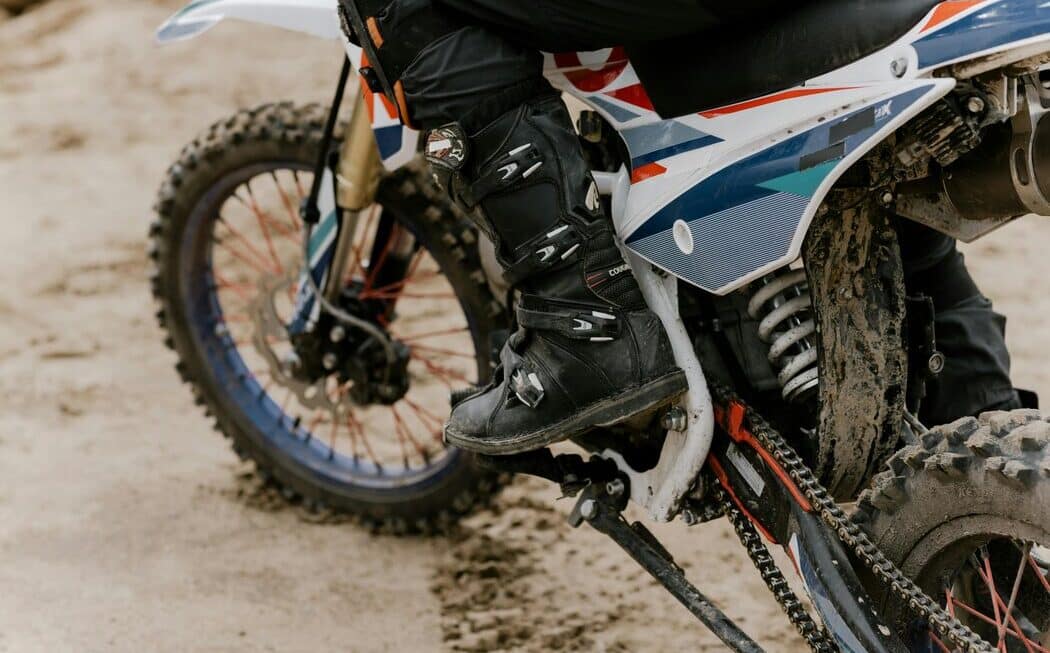Dirt bike plastics can become scratched, faded, or cracked over time. Whether from regular wear and tear, or an unfortunate accident, plastic degradation can affect the look of your bike and even impair its performance. Fortunately, restoring your dirt bike plastics to their original glory is easier than you might think. Here we have explained multiple methods about how to restore dirt bike plastics. Enjoy this reading!
Having a properly maintained and updated dirt bike is essential for the thrill-seeking motorcyclist. With the high speeds and off-road activities that accompany dirt biking, it is important to keep your bike looking its best. One of the most visible areas of any bike that is often neglected is the plastics. Over time, dirt bike plastics become scratched, faded, and even cracked. But don’t worry; restoring your dirt bike plastics is easier than you think.
How to Restore Dirt Bike Plastics (Step by Step Guide)
Step 1:
The first step of bath time was to remove all fixtures and fittings. Some rubber grommets were left on since warm water helps them become easier to take out. The age of the originals could have been 20+ years, meaning that there was nothing special about this stage. I used warm soap water with a sponge and scourer to remove as much mud and gunk as possible from the fixture pieces.
Some pieces also had stickers attached to them, so it was necessary to let those soak in the bottom of the sink while I washed another piece to help soften the glue. This way I could make sure that all pieces were properly cleaned for installation when it’s time for reinstallation. It helped break up any extra stubborn dirt or grime for a better result with no scratches or marks left behind from using too abrasive cleaning materials which are not suitable for delicate surfaces like porcelain.
Step 2:
When it comes to removing deep scratches from plastic panels, a Stanley blade can be an efficient tool for quick progress. While scratching with a Stanley blade is an effective way to remove the scratches, some risks come with it. Firstly, it’s important to ensure that the surface area where you are scratching is clean and free from any dirt or dust before beginning. If not, this could cause further damage during the process. Secondly, when using a Stanley blade you must keep a steady hand and make sure the pressure is even across the plastic as over-exerting could result in deeper scratches than were initially present.
Furthermore, due to the size of the blade, it can be easy for fingers to slip onto its edge which can lead to further jolts and jerks which may leave deeper permanent marks on the plastic panel. To avoid this issue, always wear protective gloves when working with sharp tools such as a Stanley blade and consider using a foam tool grip for better control on surfaces such as plastic panels.
Step 3:
The wet and dry sandpaper process is a crucial step in getting your project to look its best. By using the finest grade possible – preferably 120-grit – you can reduce the amount of work that has to be done and ensure that your surface comes out smooth and even. It will take some time, but it’s worth it when you see the amazing results!
Start with the corners first. Wet Sanding involves lightly dampening each section before applying the sandpaper and moving your hand in a circular motion until all rough edges are gone. Next, use a piece of very fine 400- or 600-grit sandpaper to remove any scratches left by the coarser grit. Finish off by using a chamois cloth to round out any ridges or dips left behind during sanding, ensuring an immaculate finish on every part of your project.
Step 4:
It is important to take your time and proceed with caution throughout the polishing stage of the plastic renovation process. Be sure to clean off any dust or debris accumulated during prior sanding stages and then start with a lower grade polish such as 3-4 on the buffer to gradually remove the minor blemishes that remain after sanding. As you progress, move up the polishing scale until you reach 1200 grit. At this point, your results should be satisfactory and it is time to begin adding some shine back into your plastics.
How to Restore Dirt Bike Plastics (Dirt Bike Plastics Polishing)
If you want to know, how to restore dirt bike plastics, the other way is dirt bike plastics polishing. There are multiple methods used for polishing plastics. Many people have found success with an electric buffer or a drill attachment application. I experimented with both options and found no real difference between them. The drill attachment option requires little additional investment if you own a drill already and can cost as little as a few quid otherwise, so it’s likely to be a more popular choice for those seeking an economical approach to achieving a glossy finish in their projects.
Make Sure Your Plastics Are Clean
When dealing with plastic materials, it is essential to make sure that they are clean and free from dirt, grime, and grease before use. To ensure this happens efficiently, soak the plastics in a sink or container filled with warm water and dish soap for several minutes. This provides the opportunity to scrub off any patches of dirt or grease with a brush, such as an old toothbrush. To make sure that all the soap suds are gone afterward, rinse off the plastics using a hose or outside faucet so that no foam or stickiness remains on their surface.
This first step of ensuring that your plastics are clean is fundamental for when you need to start working on them. Without making sure that all the unwanted residue has been eliminated from the material’s surface, you could be compromising the quality of your project. Soaking them in warm water and liquid soap helps loosen any caked-on spots while providing a thorough cleaning without too much effort required on your end. And don’t forget to take those extra precautionary measures by rinsing off all soapy water – no matter how clean it might look at first glance.
Clean The Stains Away
When it comes to stain removal, baking soda is one of the most effective methods. Its abrasive nature works great for getting rid of stubborn grease stains. Simply add some baking soda to the area and scrub in small circular motions with a damp cloth – you should start seeing your stain disappear after doing this for a few minutes. Be sure to rinse off the area thoroughly afterward.
Vinegar can be added to baking soda if you would prefer it over other common household cleaners. Simply mix equal parts vinegar and baking soda and apply it on the stained area, scrubbing it gently in circular motions until the stain has been removed. After using vinegar, make sure to rinse off any residue as it can leave behind an unpleasant smell. No matter what method you use, try to act quickly when dealing with stains – they become infinitely harder to remove the longer they sit!
Remove The Rust
Removing rust is an essential step to getting a fresh-looking dirt bike. Rust corrodes and weakens the metal, leaving it looking dull and aged. Therefore, it is important to take the necessary measures to remove rust and restore its original beauty.
The first step is to use a chemical cleaning agent such as WD40 or rubbing alcohol to soften the corrosion and loosen the rust particles. Simply spray or apply these substances on a rag and scrub away at the rusty area for best results. If needed, steel wool can be used as well. It is important to scrub carefully to avoid damaging the paint job underneath the rust. After removing all of the rust, make sure that you wipe off any excess residue with a rag or cloth before riding your dirt bike once more.
If you find that you’re still having difficulty removing all of the rust, it may be worth contacting a professional service that specializes in rust removal and repair. They will have all of the correct tools and experience needed for them to provide you with an outstanding job that will last for years to come.
Soak The Plastics In Water & Dish Soap
Soaking dirt bike plastics in warm water and dish soap is essential for removing any lingering odors, stains, and other traces of dirt or grime. To do this effectively, fill both of your buckets with warm water and a generous amount of dish soap. Then carefully place the dirt bike plastics into the soapy solution and let them soak for a few minutes. This will help to dissolve any gunk that may be clinging to the surface of the plastic and causing unpleasant smells or unsightly stains.
Once your plastic components have been adequately soaked, it’s important to rinse them thoroughly. You can do this by either running them through cold water or using a hose sprayer to ensure that all of the soapy residue has been removed. Once everything has been rinsed off completely, you can proceed with drying off your plastics so they’re ready for reassembly on your dirt bike!
Dry Plastics Out
The fifth step in the process of cleaning dirt bike plastics is to dry them off. After you’ve rinsed the plastic components with warm water, you need to ensure that they don’t remain wet as this can cause additional damage or lead to mold or mildew growth. To dry your plastics off, you can either use a fan to speed up the drying process or an air compressor if needed. Make sure to place the fan near your plastics so that it circulates the warm air around all surfaces, and blow the compressed air over all sides of the parts. Be careful not to direct a stream of cold air at any one specific area for too long as it could result in cracking your plastics.
When drying off dirt bike plastics, it’s important to pay attention and make sure no moisture remains on any surfaces. If not dried properly, extra moisture can damage rubber seals or cause other problems such as rusting metal parts. Be sure to wipe off excess water with a clean cloth and carefully inspect all sections of each part before moving on to another step. Properly drying your dirt bike plastics will help them last longer and stay looking great for years to come!
Give Plastics A Fresh Coat Of Paint
Giving your dirt bike plastics a fresh coat of paint is an easy way to give them a new look. Spray paint can be used to quickly and easily apply a new color, or you can choose to do some hand painting for more intricate designs and details. Either way, make sure that you mask off any parts of the bike that shouldn’t get painted – such as drive chains, bearings, and shocks – with several layers of painter’s tape. This will help ensure a smooth finish and reduce the chances of any paint getting on other areas of your dirt bike.
Once you’ve finished painting the plastics it’s important to seal them with protective sealant. This will protect them from scratches and add another layer of protection against UV rays which can often cause fading colors over time. Sealants are simple to apply but it might be wise to consult the instructions on the package for the best results. By sealing the Dirt Bike plastics you should be able to get more years out of its vibrant color before needing any future touch-ups!
Enjoy Your New Dirt Bike Plastics!
The process of cleaning and repainting dirt bike plastics can be a labor-intensive project, but the results make the work worth it. Now that your plastics have been restored to looking like new, it’s time to enjoy the fruits of your labors. A ride on your freshly painted machine is sure to turn heads—whether you’re on the track or off-road.
Whether you feel that rev of engines and adrenaline rush as you zoom around tight curves on the track, or simply enjoy taking off down a quiet trail with nature all around you, having pristine new plastic makes every ride better. Enjoying your new dirt bike plastics means being able to show everyone how clean and bright they look out in the sunshine; nothing beats vibrant colors against a backdrop of pure blue sky. Enjoying your refreshed plastics also brings added confidence knowing that they won’t crack, become mottled, or fade anytime soon; with proper maintenance, they will stay in their shiny glory for months to come.
Other Methods You Can Use
Using other methods instead of just washing or scrubbing to clean and protect plastic surfaces can help extend their life and ensure they stay looking good longer. One method is to use a degreaser to remove any dirt or grime that may have built up over time. Allow the degreaser to sit for a few minutes before wiping it down with clean water, and then air-drying. After the plastic is completely dry, an acrylic protectant can be applied which will give it additional protection from future moisture and debris.
You can also use rubbing alcohol to clean plastics since its components help cut through and lift stubborn dirt and grime. Make sure the surface area is completely dry after cleaning with the alcohol solution then apply a polishing wax on top of the plastics. This provides an additional layer of protection that repels water by making them more hydrophobic. If the dirt won’t budge with just rubbing alcohol, using a mild soap in conjunction with a scrub brush should do the trick for removing tougher stains from stubborn areas. After rinsing off any remaining residue, allow it to air dry before applying protective coatings or waxes otherwise they could leave streaks or smudges on your plastic material’s surface.
Conclusion
In conclusion, restoring your dirt bike plastics to look brand new doesn’t have to be a difficult task. It requires some time and effort, but the results will speak for themselves. No matter whether you choose to take your dirt bike to a professional detailer or decide to do it yourself, the methods outlined in this article are all reliable ways how you make your plastic shine and luster like new. Taking extra care when cleaning and polishing your plastics, as well as avoiding certain situations that can damage them are all great ways how you can keep them looking new even after months of hard riding. We truly hope this article has helped you maintain your dirt bike’s condition and that you achieve the desired results with whatever method you choose to try!


